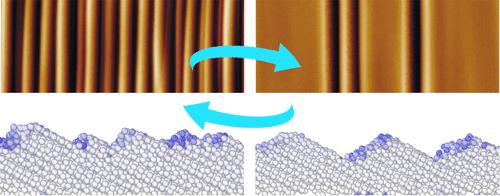当前位置:
X-MOL 学术
›
ACS Appl. Nano Mater.
›
论文详情
Our official English website, www.x-mol.net, welcomes your
feedback! (Note: you will need to create a separate account there.)
Morphological Transition of Vicinal 4H-SiC Surface Observed during Repeated Annealing
ACS Applied Nano Materials ( IF 5.3 ) Pub Date : 2022-09-29 , DOI: 10.1021/acsanm.2c04108 Xi-Wen Chen 1 , Rao Huang 1
ACS Applied Nano Materials ( IF 5.3 ) Pub Date : 2022-09-29 , DOI: 10.1021/acsanm.2c04108 Xi-Wen Chen 1 , Rao Huang 1
Affiliation

|
Step-bunching has attracted sustained attention due to its remarkable influence on the properties of SiC, which is a versatile functional material in the power and optoelectronic fields. Here, step-bunching morphology on the vicinal 4H-SiC surface is discovered to transform among the morphologies with different step sizes and distribution patterns in repeated annealing experiments. Meanwhile, a multiple-hill-valley model, based on the experimental observations, is adopted to analyze the surface energetics, from which the obtained morphologies are verified to be metastable states that can be steadily maintained and thermally accessible from one another. Moreover, for the purpose of elucidating the surface morphology evolution at an atomic scale, molecular dynamics simulations were performed. The results show that at high temperatures, the fluctuation of the number of steps on the surface is extremely active, while the final morphology depends on the cooling rate. Furthermore, the change in step-bunching structure originates from larger steps splitting and smaller ones merging, along with massive atomic migrations. Finally, during the high-temperature process, the atomic trajectories are basically localized along the peripheries of the (0001) facets. These results provide insights into the mechanisms of step-bunching formation and transformation, which are of referential significance to the preparation and application of SiC for the next generation of nanoelectronic technology.
中文翻译:

重复退火过程中观察到的邻位 4H-SiC 表面的形态转变
阶梯聚束因其对 SiC 性能的显着影响而受到持续关注,SiC 是电力和光电领域的多功能功能材料。在这里,发现在重复退火实验中,邻位 4H-SiC 表面上的阶梯状形态在具有不同步长和分布模式的形态之间发生转换。同时,采用基于实验观察的多山-谷模型来分析表面能量学,从中验证所获得的形态是亚稳态,可以稳定地保持和彼此热可访问。此外,为了在原子尺度上阐明表面形态演变,进行了分子动力学模拟。结果表明,在高温下,表面步数的波动非常活跃,而最终形态取决于冷却速度。此外,台阶聚束结构的变化源于较大的台阶分裂和较小的台阶合并,以及大规模的原子迁移。最后,在高温过程中,原子轨迹基本集中在(0001)晶面的外围。这些结果提供了对阶跃聚束形成和转变机制的深入了解,对于下一代纳米电子技术中SiC的制备和应用具有参考意义。阶梯聚束结构的变化源于较大的阶梯分裂和较小的阶梯合并,以及大规模的原子迁移。最后,在高温过程中,原子轨迹基本集中在(0001)晶面的外围。这些结果提供了对阶跃聚束形成和转变机制的深入了解,对于下一代纳米电子技术中SiC的制备和应用具有参考意义。阶梯聚束结构的变化源于较大的阶梯分裂和较小的阶梯合并,以及大规模的原子迁移。最后,在高温过程中,原子轨迹基本集中在(0001)晶面的外围。这些结果提供了对阶跃聚束形成和转变机制的深入了解,对于下一代纳米电子技术中SiC的制备和应用具有参考意义。
更新日期:2022-09-29
中文翻译:

重复退火过程中观察到的邻位 4H-SiC 表面的形态转变
阶梯聚束因其对 SiC 性能的显着影响而受到持续关注,SiC 是电力和光电领域的多功能功能材料。在这里,发现在重复退火实验中,邻位 4H-SiC 表面上的阶梯状形态在具有不同步长和分布模式的形态之间发生转换。同时,采用基于实验观察的多山-谷模型来分析表面能量学,从中验证所获得的形态是亚稳态,可以稳定地保持和彼此热可访问。此外,为了在原子尺度上阐明表面形态演变,进行了分子动力学模拟。结果表明,在高温下,表面步数的波动非常活跃,而最终形态取决于冷却速度。此外,台阶聚束结构的变化源于较大的台阶分裂和较小的台阶合并,以及大规模的原子迁移。最后,在高温过程中,原子轨迹基本集中在(0001)晶面的外围。这些结果提供了对阶跃聚束形成和转变机制的深入了解,对于下一代纳米电子技术中SiC的制备和应用具有参考意义。阶梯聚束结构的变化源于较大的阶梯分裂和较小的阶梯合并,以及大规模的原子迁移。最后,在高温过程中,原子轨迹基本集中在(0001)晶面的外围。这些结果提供了对阶跃聚束形成和转变机制的深入了解,对于下一代纳米电子技术中SiC的制备和应用具有参考意义。阶梯聚束结构的变化源于较大的阶梯分裂和较小的阶梯合并,以及大规模的原子迁移。最后,在高温过程中,原子轨迹基本集中在(0001)晶面的外围。这些结果提供了对阶跃聚束形成和转变机制的深入了解,对于下一代纳米电子技术中SiC的制备和应用具有参考意义。































 京公网安备 11010802027423号
京公网安备 11010802027423号